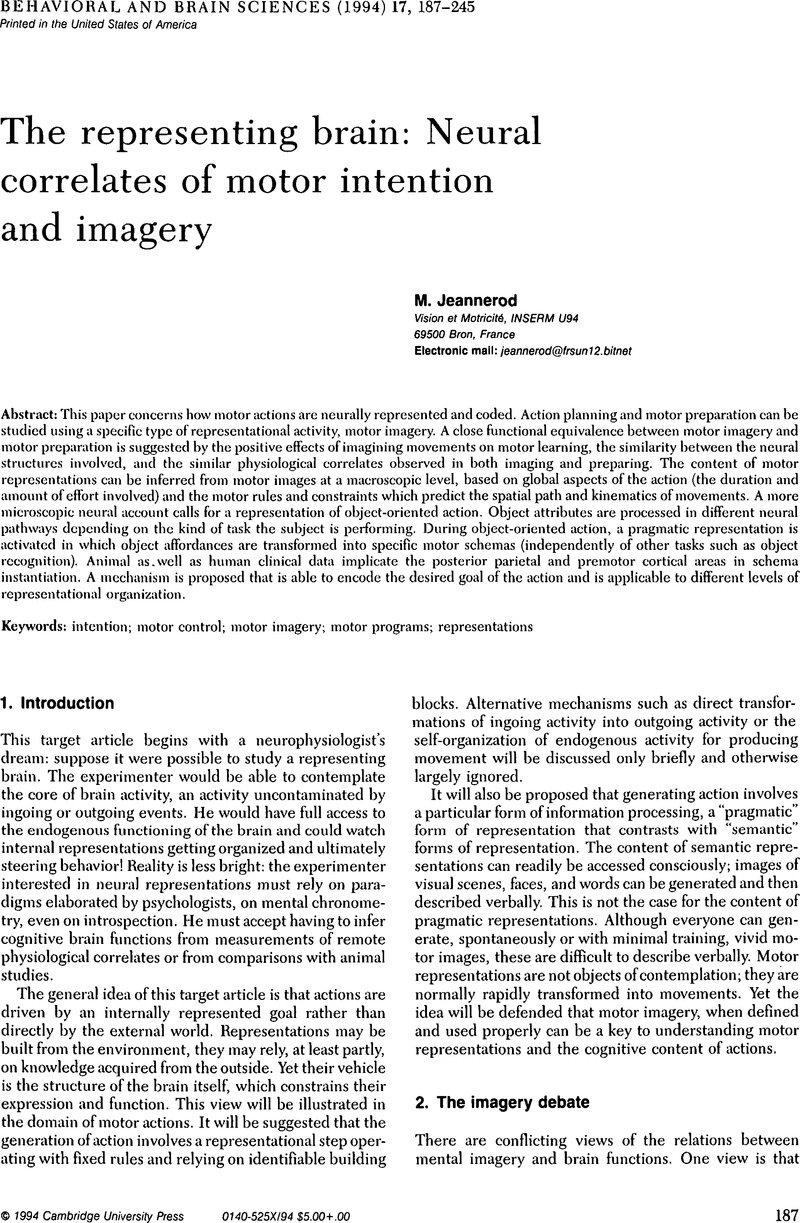Crossref Citations
This article has been cited by the following publications. This list is generated based on data provided by Crossref.
Jeannerod, M.
1995.
Mental imagery in the motor context.
Neuropsychologia,
Vol. 33,
Issue. 11,
p.
1419.
Lang, Wilfried
Cheyne, Douglas
Höllinger, Peter
Gerschlager, Willi
and
Lindinger, Gerald
1996.
Electric and magnetic fields of the brain accompanying internal simulation of movement.
Cognitive Brain Research,
Vol. 3,
Issue. 2,
p.
125.
Decety, Jean
1996.
The neurophysiological basis of motor imagery.
Behavioural Brain Research,
Vol. 77,
Issue. 1-2,
p.
45.
Yahagi, Susumu
Shimura, Kuniyoshi
and
Kasai, Tatsuya
1996.
An Increase in Cortical Excitability with No Change in Spinal Excitability during Motor Imagery.
Perceptual and Motor Skills,
Vol. 83,
Issue. 1,
p.
288.
Pfurtscheller, G.
Neuper, Ch.
Flotzinger, D.
and
Pregenzer, M.
1997.
EEG-based discrimination between imagination of right and left hand movement.
Electroencephalography and Clinical Neurophysiology,
Vol. 103,
Issue. 6,
p.
642.
Schnitzler, Alfons
Salenius, Stephan
Salmelin, Riitta
Jousmäki, Veikko
and
Hari, Riitta
1997.
Involvement of Primary Motor Cortex in Motor Imagery: A Neuromagnetic Study.
NeuroImage,
Vol. 6,
Issue. 3,
p.
201.
Bonnet, M
Decety, J
Jeannerod, M
and
Requin, J
1997.
Mental simulation of an action modulates the excitability of spinal reflex pathways in man.
Cognitive Brain Research,
Vol. 5,
Issue. 3,
p.
221.
Decety, J
and
Boisson, D
1997.
Anticipation, représentations et schéma corporel à la lumière des neurosciences cognitives.
Annales de Réadaptation et de Médecine Physique,
Vol. 40,
Issue. 2,
p.
63.
1997.
Le cerveau en action.
p.
255.
Kasai, T
Kawai, S
Kawanishi, M
and
Yahagi, S
1997.
Evidence for facilitation of motor evoked potentials (MEPs) induced by motor imagery.
Brain Research,
Vol. 744,
Issue. 1,
p.
147.
Yahagi, Susumu
and
Kasai, Tatsuya
1998.
Facilitation of motor evoked potentials (MEPs) in first dorsal interosseous (FDI) muscle is dependent on different motor images.
Electroencephalography and Clinical Neurophysiology/Electromyography and Motor Control,
Vol. 109,
Issue. 5,
p.
409.
Mellet, E.
Petit, L.
Mazoyer, B.
Denis, M.
and
Tzourio, N.
1998.
Reopening the Mental Imagery Debate: Lessons from Functional Anatomy.
NeuroImage,
Vol. 8,
Issue. 2,
p.
129.
Johnson, Scott H.
1998.
Cerebral Organization of Motor Imagery: Contralateral Control of Grip Selection in Mentally Represented Prehension.
Psychological Science,
Vol. 9,
Issue. 3,
p.
219.
Höllinger, P
Beisteiner, R
Lang, W
Lindinger, G
and
Berthoz, A
1999.
Mental representations of movements. Brain potentials associated with imagination of eye movements.
Clinical Neurophysiology,
Vol. 110,
Issue. 5,
p.
799.
Geyer, Stefan
Schleicher, Axel
and
Zilles, Karl
1999.
Areas 3a, 3b, and 1 of Human Primary Somatosensory Cortex.
NeuroImage,
Vol. 10,
Issue. 1,
p.
63.
Johnson, Scott H
2000.
Thinking ahead: the case for motor imagery in prospective judgements of prehension.
Cognition,
Vol. 74,
Issue. 1,
p.
33.
Johnson, Scott H
Corballis, Paul M
and
Gazzaniga, Michael S
2001.
Within grasp but out of reach: evidence for a double dissociation between imagined hand and arm movements in the left cerebral hemisphere.
Neuropsychologia,
Vol. 39,
Issue. 1,
p.
36.
Pfurtscheller, G.
and
Neuper, C.
2001.
Motor imagery and direct brain-computer communication.
Proceedings of the IEEE,
Vol. 89,
Issue. 7,
p.
1123.
Papaxanthis, Charalambos
Pozzo, Thierry
Skoura, Xanthi
and
Schieppati, Marco
2002.
Does order and timing in performance of imagined and actual movements affect the motor imagery process? The duration of walking and writing task.
Behavioural Brain Research,
Vol. 134,
Issue. 1-2,
p.
209.
Pfurtscheller, Gert
and
Neuper, Christa
2003.
The Bereitschaftspotential.
p.
191.



